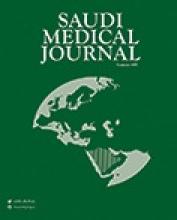ORIGINAL ARTICLES
Novel association between heterozygous genotype of single nucleotide polymorphism C218T in drug transporter ABCC1 gene and increased risk of colon cancer
Abdulkhaleq et al determine the role of G128C and C218T variants in ABCC1 gene with the risk of developing colon cancer. The results showed a novel association between heterozygous (CT) genotype for variant C218T and increased risk of colon cancer [OR=3.4, 95% CI (1.56-7.48), and RR=1.92, 95% CI (1.26-2.93), p=0.002]. These ratios were correlated with high-grade stages (III and IV). In contrast, for variant G128C, there was no significant association with the risk of developing colon cancer. They conclude that the CT genotype of variant C218T in ABCC1 gene may increase the risk of developing colon cancer.
see page 224
Computed tomography pulmonary angiography using high-pitch dual-source scanner technology
Al Hassan et al compare use of ultra-fast high-pitch dual-source free-breathing computed tomography pulmonary angiogram (CTPA) with conventional standard-pitch single-source breath-hold CTPA. Improved image quality (optimal studies without artifacts 91%) was seen in Group-2 compared to Group-1 (optimal studies without artifacts 75.4%). Also, reduced scan time (1-2 sec.) and radiation dose (mean dose length product (DLP)-248 mGy-cm) were observed in Group-2 compared to Group-1 (scan time- 6.5 sec, mean DLP-375). Results were found significant (p<0.05). They conclude that high-pitch dual-source CT with free-breathing yields better image quality, reduces image acquisition time and radiation doses.
see page 230
Axial computed tomography pulmonary angiogram image (mediastinal window) showing streak artifacts
Diabetic patients in Saudi Arabia. The evaluation of glycemic control measures based on emergency department utilization and the percentages of adherence to the recommended follow-ups for microvascular complications.
Alshareef et al determine the association between emergency department (ED) visits, glycemic control and the quality of preventive diabetes care among diabetic patients in a Saudi community. This study found statistically significant relationships (p<0.05) between ED visits and patient age, the glycated hemoglobin (HbA1c) and education level. Emergency department visits increased by 43% for each unit of increase in HbA1c (odds ratio [OR]=1.43, 95% confidence interval (CI)=1.26-1.62). Graduating from high school decreased the odds of visiting the ED by 43% (OR=0.57, 95% CI=0.34-0.94). Most of the participants were not followed for possible microvascular complications; the majority did not visit nephrology (96.2%), ophthalmology (78.3%) and neurology (97.9%) clinics within the 12 months prior to the interviews. They conclude that ED visits can indicate poor glycemic control in diabetic patients. Additionally, the current practices of preventive diabetes care in Saudi Arabia are not sufficient, according to the diabetic standards of care recommended by the American Diabetes Association.
see page 271
CASE REPORT
Cutaneous draining sinus tract of odontogenic origin. A case of chronic misdiagnosis
Al-Obaida & Al-Madi present a patient with a buccal cutaneous sinus tract, originally misdiagnosed, with delayed healing and potential malpractice. An odontogenic cutaneous sinus tract is a pathologic canal that initiates in the oral cavity but opens externally at the cutaneous surface of the face or neck. It is frequently misdiagnosed, leading to inappropriate treatment. Once correct diagnosis is made, definitive treatment, through oral therapy to eliminate the source of infection, is simple and effective. This case was initially misdiagnosed as a sebaceous cyst and laceration of parotid gland. The case was correctly diagnosed through detailed examination and evaluation, using tracing and advanced imaging technology (cone beam imaging). Endodontic treatment was performed, which resulted in rapid resolution of the case, followed by dermatologic treatment with fractional laser to treat the scar formed.
see page 292
Extra oral healing after one week post endodontic treatment.
- Copyright: © Saudi Medical Journal
This is an open-access article distributed under the terms of the Creative Commons Attribution-Noncommercial-Share Alike 3.0 Unported, which permits unrestricted use, distribution, and reproduction in any medium, provided the original work is properly cited.








